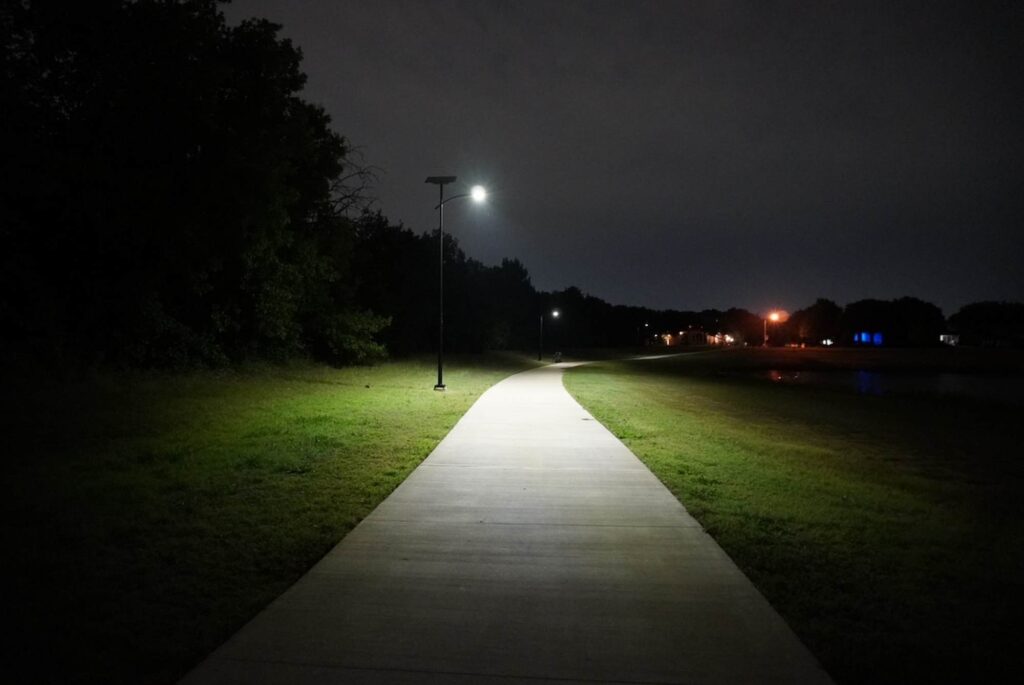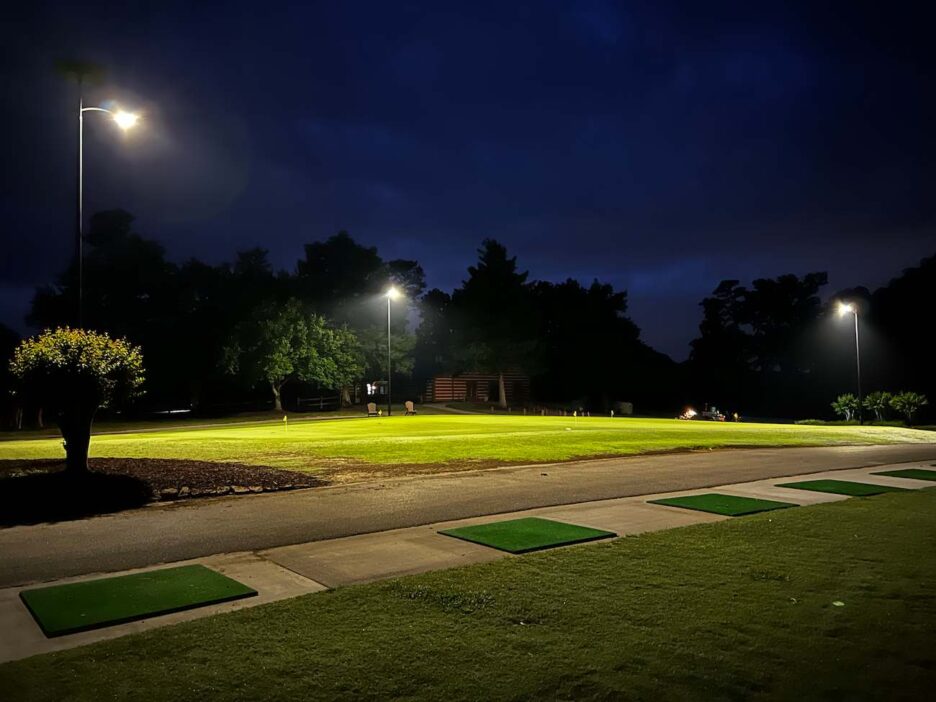Across Alabama, cities and counties are investing in trails, bike paths, and greenways to encourage recreation, improve connectivity, and boost community well-being. But when the sun sets, these valuable assets can become safety risks without proper lighting. Poor visibility limits evening use, discourages residents, and raises liability concerns for local agencies.
Traditional grid-tied lighting often creates more problems than it solves. Running underground wiring through wooded areas, wetlands, or paved paths is expensive, environmentally disruptive, and slow to deploy. Many rural or grant-dependent projects simply cannot afford the costs and delays of trenching.
Fonroche SmartLights provides a better option. These fully off-grid solar lighting systems, installed without trenching, deliver reliable dusk-to-dawn illumination year-round and operate maintenance-free for more than a decade. With eligibility under programs like RTP, TAP, and CDBG, they offer parks and recreation leaders a grant-aligned solution that keeps trails safe while protecting both natural environments and local budgets.
Why Trail Lighting Projects Face Unique Challenges
Trail and pathway lighting projects are rarely simple. Trenching underground wiring can damage soil, tree roots, and wetlands, creating long-term environmental impacts. Even once designs are complete, projects that cross public or protected lands often face lengthy permitting delays.
Remote greenways present another hurdle: access to grid power is limited, driving up installation costs. For lower-traffic trails, the price of trenching and ongoing utility bills is difficult to justify. And because many park projects depend on time-sensitive grants, delays in installation can mean lost funding and stalled community improvements.
Why Solar is the Ideal Fit for Trails and Greenways
Traditional wired lighting often creates more problems than it solves for parks and pathways. Fonroche SmartLights are designed specifically for these environments, offering quick deployment, long-term reliability, and funding alignment that makes projects easier to plan and deliver.
Key advantages include:
No trenching or environmental disruption
- Unlike grid-tied systems, SmartLights require no underground cabling. This avoids tearing up trails, disturbing tree roots, or cutting through sensitive wetlands, helping preserve natural habitats and protect the very landscapes these projects are meant to showcase.
Quick installation
- Each unit installs in under an hour and can be operational the same day. This makes it possible to add lighting during short project windows, such as between grant approvals and community opening dates, without delaying construction or public access.
Fully off-grid performance
- Every SmartLight is powered by Fonroche’s Power 365™ energy management system, which guarantees dusk-to-dawn illumination 365 nights a year. Even in periods of cloud cover or stormy weather, lights continue to operate reliably with no dependency on the utility grid.
Built for rural and wooded terrain
- SmartLights are engineered to perform in tough environments. From Alabama’s humid summers to storm-prone wooded areas, they withstand heat, moisture, and wind loads that often compromise conventional lighting systems.
Grant eligibility
- Many trail and pathway projects depend on grant funding. SmartLights qualify under programs such as the Recreational Trails Program (RTP), the Transportation Alternatives Program (TAP), Community Development Block Grants (CDBG), and other resilience-focused initiatives, making it easier to secure funding and move projects forward.
Zero ongoing costs
- With no trenching, no utility bills, and no scheduled maintenance for more than a decade, SmartLights dramatically reduces the total cost of ownership. Parks and municipalities can allocate budgets to new amenities rather than ongoing energy and maintenance expenses.

Where SmartLights Fit Best
Because they install quickly and operate completely off-grid, Fonroche SmartLights are versatile enough to serve a wide variety of trail and pathway projects. From urban greenways to rural nature preserves, they provide reliable lighting exactly where it’s needed most.
Recreational trails in city and state parks
- Keep walking and jogging paths safe after dark without trenching through landscaped areas or disrupting park operations. Solar lighting extends public use while preserving natural beauty.
Bike paths and pedestrian corridors
- Support safe, connected mobility networks by adding consistent illumination along commuter routes and recreational corridors. SmartLights improve visibility for cyclists and pedestrians alike.
Trailheads, rest stops, and wayfinding stations
- Provide well-lit entry points, gathering areas, and informational signage so users feel secure when starting or ending their journey. Lighting also supports navigation and helps reduce vandalism. Many trailheads connect directly to public parking lots, learn how solar parking lot lighting in Alabama keeps these access points bright and secure.
Rural greenways with no grid access
- Deliver reliable lighting where electrical infrastructure is unavailable or cost-prohibitive. SmartLights are an ideal fit for remote parks and long-distance pathways in Alabama’s rural counties. Similar off‑grid lighting is transforming county roads statewide. See how rural roadway lighting in Alabama closes safety gaps across underserved regions.
Lighting upgrades for ADA accessibility projects
- Ensure trails and pathways meet accessibility standards by providing uniform illumination that reduces tripping hazards and supports safe navigation for all users.
Multi-use paths near schools, rivers, or nature centres
- Extend safe use of popular community amenities by adding lighting where children, families, and visitors gather for evening recreation, education, or events.
FAQs: Trails and Pathway Lighting with Solar
How can we light trails without damaging natural areas or disrupting habitats?
Fonroche SmartLights are installed above ground with no trenching or underground wiring, which means there’s no need to cut through soil, roots, or wetlands. This protects sensitive ecosystems and preserves the natural character of parks and greenways.
What makes solar better suited for remote trails and greenways than grid lighting?
Many rural trails have limited or no access to grid power, making wired systems expensive or impossible to install. SmartLights are completely off the grid, allowing safe, reliable lighting in even the most remote or unpowered locations.
Can SmartLights meet visibility and safety standards for multi-use paths?
Yes. SmartLights are designed to meet IES outdoor lighting standards and provide uniform illumination across walking and biking paths. They also support ADA compliance, reducing tripping hazards and improving accessibility for all users.
How quickly can solar trail lighting be installed and operational?
Each unit can be installed in under an hour with no trenching or utility coordination. This makes it possible to complete trail lighting projects in days rather than weeks or months.
What grant programs commonly support trail and pathway lighting projects in Alabama?
Solar trail lighting may qualify under the Recreational Trails Program (RTP), Transportation Alternatives Program (TAP), Community Development Block Grants (CDBG), and state-managed energy or resilience funds through ADECA.
Can solar be added to existing trails that were built without lighting?
Absolutely. Because each SmartLight is standalone and modular, units can be added at any point, whether during a retrofit, phased expansion, or as part of a community upgrade.
How do SmartLights hold up in wooded areas with shade or during stormy weather?
SmartLights use Power 365™ energy management technology, which stores energy to guarantee 365 nights of lighting per year. They are built to withstand Alabama’s climate, including heat, humidity, and severe storms.
Conclusion: A Smarter Way to Light Alabama’s Trails and Pathways
Alabama’s trails and greenways are vital community assets, but they require safe and reliable lighting to remain accessible after dark. Fonroche SmartLights make that possible, delivering dusk-to-dawn illumination with no trenching, no grid access, and no maintenance for more than a decade.
With grant eligibility through programs like RTP, TAP, and CDBG, these systems are also budget-friendly and easy to fund. For parks departments, transportation planners, and rural counties, SmartLights provide the fastest path to safer, more sustainable trails.

